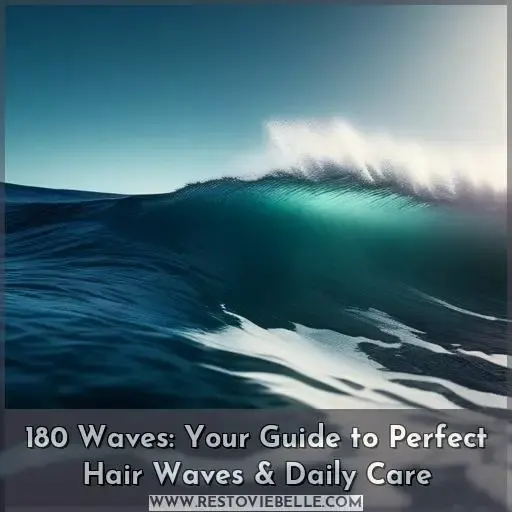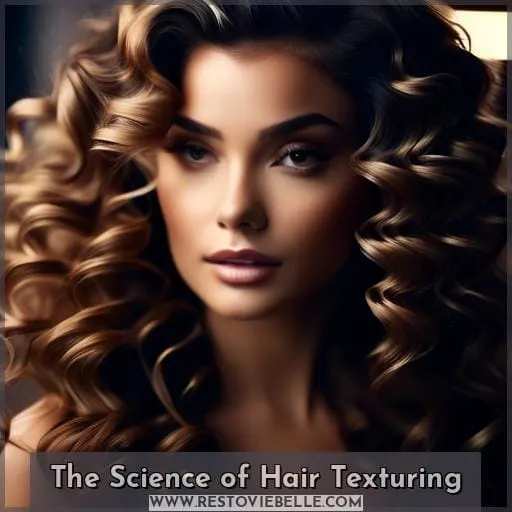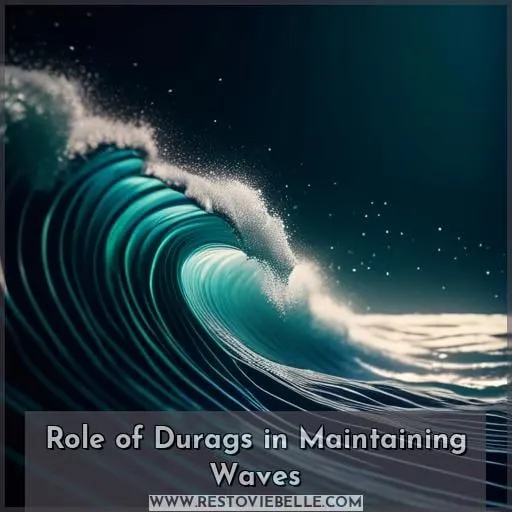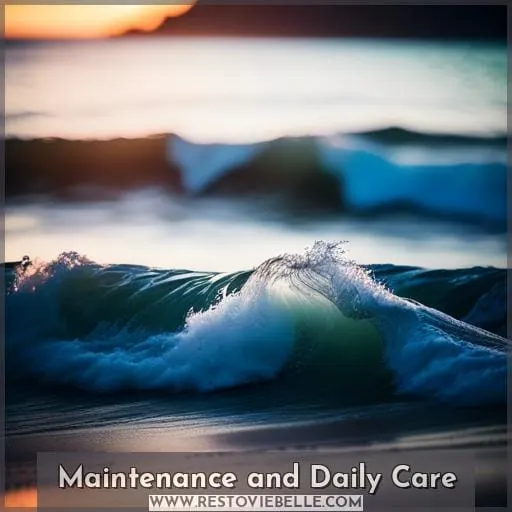This site is supported by our readers. We may earn a commission, at no cost to you, if you purchase through links.
 Discover the art of crafting perfect 180 waves, a timeless hairstyle that combines tradition and technique.
Discover the art of crafting perfect 180 waves, a timeless hairstyle that combines tradition and technique.
This guide will delve into the historical roots and cultural impact of wave styles, explore the science behind hair texturing, and provide a practical, step-by-step approach to achieving those coveted ripples.
You’ll learn the importance of the right haircut, brushing methods, and the essential role of wave pomades and moisturizers.
Plus, understand how durags contribute to wave maintenance and get tips for daily care to keep your waves sharp and stylish.
Embrace your hair’s potential and master the skill of 180 waves with confidence.
Table Of Contents
- Key Takeaways
- Historical Origins and Cultural Significance
- The Science of Hair Texturing
- Step-by-Step Guide to Achieving 180 Waves
- Role of Durags in Maintaining Waves
- Maintenance and Daily Care
- Frequently Asked Questions (FAQs)
- Can 180 waves be achieved on any hair type or are they specific to certain textures?
- How does one manage 180 waves while engaging in frequent swimming or water activities?
- Are there any specific dietary or health considerations that can affect the development and maintenance of 180 waves?
- What are the environmental factors, such as humidity or temperature, that can impact the styling and longevity of 180 waves?
- How do different hair lengths affect the process and appearance of 180 waves?
- Conclusion
Key Takeaways
- Cultural identity and personal expression play significant roles in the adoption and maintenance of 180 waves, highlighting the hairstyle’s deep roots in regional diversity and its status as a symbol of pride and resilience amidst appropriation and discrimination.
- The science behind hair texturing is crucial for achieving 180 waves, with factors such as hair texture, moisture, scalp health, and porosity affecting wave formation and necessitating the use of products tailored to individual hair types and needs.
- A systematic approach is essential for developing 180 waves, involving steps like a personalized haircut, thorough hair washing, pre-wave treatment, consistent brushing and grooming, and the application of specific wave pomades and moisturizers to encourage and maintain wave patterns.
- Durags are indispensable for preserving 180 waves, especially during sleep, by protecting the hairstyle and maintaining moisture. The choice of material (satin or silk) and the method of tying the durag are critical for comfort, securing the waves, and ensuring the longevity of the hairstyle.
Historical Origins and Cultural Significance
Diving into the rich tapestry of hair waves, you’re not just styling your hair; you’re weaving a piece of history into every strand. This isn’t just about looking sharp; it’s about carrying a legacy. Waves have deep roots in cultural identity, especially within the Black community, serving as a bold statement of pride and resilience.
But let’s not sugarcoat it; this journey hasn’t been all smooth sailing. From the sands of ancient Egypt to the bustling streets of modern cities, waves have sailed through times of cultural appropriation and hairstyle discrimination, battling storms to remain a symbol of identity expression.
Each wave pattern, be it the subtle 180 or the intricate 720, tells a story of regional variations, echoing the diversity within the community itself. But here’s the kicker: while waves are a nod to where we’ve come from, they’re also a canvas for personal expression, a way to stand out in a sea of sameness.
So, as you embark on mastering this art, remember, you’re not just styling your hair; you’re carrying forward a legacy, making waves in more ways than one.
The Science of Hair Texturing
Understanding the science behind hair texturing, especially for achieving 180 waves, starts with recognizing how your hair’s natural texture plays a pivotal role in wave formation.
It’s crucial to keep your hair well-moisturized and healthy, as these factors significantly influence the ease with which you can sculpt those coveted waves.
Role of Hair Texture in Wave Formation
Your hair’s texture is a game of genetic roulette, with your DNA calling the shots on whether you’ll rock curls, waves, or straight strands.
But it’s not just about the hand you’re dealt; environmental factors and the right products can shuffle the deck. If you’re blessed with waves, your scalp health and hair porosity are key players in the wave game.
A healthy scalp is like fertile soil for your hair garden, nurturing each strand from root to tip. And porosity? Think of it as your hair’s thirst level—too thirsty (high porosity) and your waves might wilt, too low and they can’t drink up the moisture they need.
Finding that sweet spot with products that jive with your hair’s needs can turn those waves into a masterpiece.
Importance of Moisture and Hair Health
Maintaining your hair’s moisture is crucial for those perfect waves. Just as the right texture sets the stage, hydration and hair health are the show’s stars.
Think of your hair as a garden; without water, nothing grows. So, let’s dive into a protein treatment, your hair’s equivalent of a gym workout, strengthening those strands.
Don’t forget deep conditioning, the spa day that leaves your hair feeling rejuvenated. And hair vitamins? They’re the daily supplements ensuring your scalp health is top-notch.
Step-by-Step Guide to Achieving 180 Waves
To kickstart your journey towards perfect 180 waves, it’s crucial to begin with the right haircut and preparation.
Following this, mastering the art of brushing and grooming, along with the strategic application of wave pomades and moisturizers, will set the foundation for your success.
Haircut and Initial Preparation
Before diving into the wave game, let’s talk shop. Your journey begins with a solid foundation, and that’s where the haircut consultation comes into play. You’ll want to sit down with your barber and hash out a game plan tailored to your hair’s personality.
- Product selection is like choosing the right armor for battle; pick wisely to protect and fortify your hair.
- A thorough hair washing technique sets the stage for success, clearing the way for those waves to make an entrance.
- Don’t skimp on the pre-wave treatment; it’s the secret sauce that primes your locks for the transformation ahead.
Brushing and Grooming Techniques
Brushing and grooming your waves is like sculpting a masterpiece. It requires the right tools and a dash of patience.
Brush Choice:
- Opt for a wave brush that speaks to your hair type.
- Soft bristles for shorter hair.
- Firmer ones as it grows.
Brush Pattern:
- Imagine your head is a canvas.
- Paint strokes from the crown outward.
- Ensure every strand falls into place.
Grooming Frequency:
- Daily grooming is the secret sauce to turning ripples into roaring waves.
Leave-in Conditioning:
- Don’t skimp on leave-in conditioning.
- It’s the hydration your hair craves to stay healthy and pliable.
Consistency:
- Rome wasn’t built in a day, and neither are killer waves.
- Keep at it, and soon you’ll be riding the wave of compliments.
Application of Wave Pomades and Moisturizers
After mastering the art of brushing and grooming, it’s time to dive into the world of pomades and moisturizers. This step is crucial for locking in those sleek waves you’ve been working so hard to achieve.
- Choosing Pomade: Pick a pomade that complements your hair type. Whether it’s thick or thin, there’s a pomade out there for you.
- Mixing Pomades: Don’t be afraid to mix different pomades to find the perfect hold and shine. Just make sure they’re compatible.
- Applying Moisturizers: Keep your hair hydrated. Moisturizers are key to maintaining healthy, wave-ready hair.
- Hair Type Compatibility: Always consider your hair type when selecting products. What works for one mightn’t work for another.
- Transitioning Products: As your hair changes, so should your products. Be open to switching things up to suit your hair’s needs.
Role of Durags in Maintaining Waves
After meticulously brushing and applying the right products, you’ve laid the groundwork for those sleek 180 waves. But here’s the kicker: without a trusty durag, that effort might as well be a castle built on sand.
Durags aren’t just a fashion statement; they’re the guardians of your waves while you conquer the world in your sleep. Think of them as the night watchmen, ensuring no wave goes astray. When choosing durags, it’s a satin vs.
silk showdown. Satin is your budget-friendly ally, while silk is the luxury that caresses your hair with the softness of a thousand feathers.
Now, tying techniques are where the magic happens. Tie it snug, but don’t go overboard—no one’s trying to squeeze a confession out of their forehead. And remember, durags at night are like seatbelts for your hair; they keep everything in place when life’s roller coaster hits the hay.
Durag care is simple: treat it like your favorite tee. A gentle hand wash will do the trick, keeping it ready for its nightly duty. So, wrap up, tie down, and rest easy knowing your waves are under the silk or satin fortress of your trusty durag.
Maintenance and Daily Care
Maintaining your waves is like keeping a sports car in top condition; it requires a consistent regimen and the right tools.
- Stay Hydrated: Your hair’s health starts from within. Drink plenty of water to keep those waves smooth and hydrated.
- Brush Daily: Keep those brushes at hand. A daily brushing routine is the cornerstone of wave maintenance, ensuring your pattern stays defined.
- Use Quality Pomades: Don’t skimp on products. A dab of quality pomade can keep your waves laid down and add that extra sheen.
- Wrap It Up: Never underestimate the power of a good durag. Wearing it nightly locks in moisture and keeps your waves from getting disrupted while you sleep.
Frequently Asked Questions (FAQs)
Can 180 waves be achieved on any hair type or are they specific to certain textures?
Achieving 180 waves isn’t just a dream; it’s totally doable across various hair types. It’s all about the hustle—brushing, moisturizing, and rocking that durag. Whether your mane is straight as a ruler or has more curls than a rollercoaster, with the right technique and a bit of elbow grease, you’re on your way to wave city.
Just remember, it’s not a sprint; it’s a marathon. So, keep at it, and soon you’ll be riding those waves like a pro.
How does one manage 180 waves while engaging in frequent swimming or water activities?
Like a captain braving the stormy seas, you must shield your waves from the aquatic onslaught. Before diving in, saturate your hair with fresh water and a touch of conditioner to create a barrier.
Post-swim, cleanse with a sulfate-free shampoo and rehydrate with a deep conditioner.
Are there any specific dietary or health considerations that can affect the development and maintenance of 180 waves?
To keep those waves on point, focus on hydration and a balanced diet rich in proteins, vitamins, and omega-3s.
Don’t let junk food dull your shine!
What are the environmental factors, such as humidity or temperature, that can impact the styling and longevity of 180 waves?
Despite what you might think, humidity and temperature do play a big role in how your 180 waves turn out. High humidity can puff up your hair, making waves less defined, while dry air might leave your waves looking thirsty and less vibrant.
Cold temps can make your hair brittle, risking the smooth pattern you’ve worked hard for. But don’t sweat it—adjusting your moisture game and using the right products can keep your waves on point, no matter the weather.
Stay sharp, stay styled, and let those waves ride high or low, come rain or shine.
How do different hair lengths affect the process and appearance of 180 waves?
Your hair length can make or break your 180 waves journey. Too short, and you’ll miss the wave train; too long, and you’ll drown in the sea of curls.
Conclusion
You’ve got the basics down; now it’s time to rock those 180 waves with pride. Remember, your hair’s health is as crucial as the styling process. Keep up with regular brushing, apply your pomades and moisturizers, and don’t skip the durag—it’s key for wave preservation.
With dedication and the right daily care, you’ll maintain sharp, stylish waves that turn heads.










